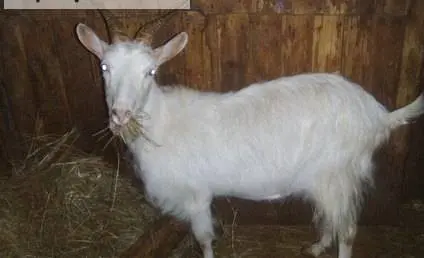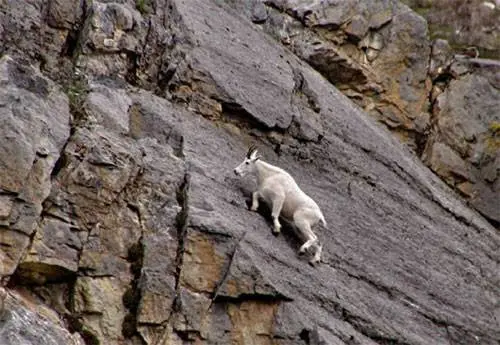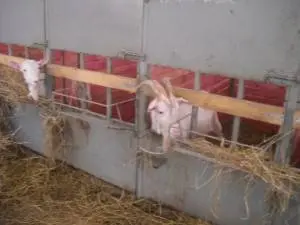Contents
Goat milk has long been popular: a healthy product that does not cause allergies. That is why it is widely used in baby food. The issue of choosing a pet should be treated carefully.
There are meat and dairy breeds.
What is this animal, how to care for it – we will consider these issues in detail.
Description
This breed was bred on the territory of Western Georgia in the 35th year of the last century. There are two types: upland and lowland
The creators are ordinary peasants from Megrelia, who did not have special knowledge.

Today, breeders, in order to improve some breed, often use Georgian goats as donors. After all, representatives of the Megrelian breed are the most highly productive.
Highland goats are distinguished by a strong constitution:
- Elongated torso, broad chest.
- Strong limbs set straight.
- elongated head with graceful ears, standing straight.
- Beautiful horns resembling a saber. If you look closely, they look like the Latin letter “S”.
- The height at the withers is approximately 70 cm.
The coat color can vary from white to light grey. There are also roans, with red-brown spots.
Productivity
- Goats most often reach a weight of 38 to 45 kg. Males – up to 55 kg. Some Megrelian goats can weigh up to 60.
- Females usually breed in twins. For one hundred goats, you can get an offspring equal to 160 kids. A productive herd is replenished without difficulty.
- With proper feeding per year, one Megrelian goat gives up to 900 kg of tasty, healthy milk, fat content up to 4%. From it you can cook various dairy products, such as cheese, cottage cheese, cheese.
Features of care
Drinking from a puddle can cause infection. In the summer heat, goats are watered twice a day, in winter, if there is wet food, once is enough.
Feeders
Galvanized dishes should not be used for feeders, so as not to poison the animal with zinc. They put dishes on elevations that reach the goat’s chest, for kids, drinkers and feeders are set lower. Water and food are given in separate containers. Many goat breeders make automatic drinkers – the water is always clean. In winter, the water needs to be heated.
What to feed
- Animals are fed with oats, barley, corn grains. Care must be taken to ensure that water does not get into the feeders with dry food.
- If potato peelings are fed, then they need to be washed and boiled. Sprinkle salt and mixed fodder on top.
- Root vegetables can be fed raw, but carefully crushed, especially for kids.
- It is good to give different mixes. Steamed oats, oatmeal, leftover food from the table, carrots, beets, cabbage are suitable. Dairy goats, eating wet food, add milk.
- In a special trough there should always be fodder salt (one goat or goat needs up to 8 kg of salt per year, little less for kids).
- In winter, besides hay, goats are given prepared brooms and pine needles. They are hung at such a level that goats and kids can reach them.
Feeding is carried out several times a day:
- in the morning – grain and root crops.
- day – hay.
- crushed grain, hay in the evening.
In summer, Megrelian goats, together with kids, graze in the highlands, in winter, if the weather permits, at the foot of the mountains.

Dairy goat care rules
For goats of the Megrelian breed, a special room is needed, it is called a goat’s rue. The height of the room is about 3 meters. Square:
- per pistil with offspring is not less than 2,5 square meters. m;
- a single goat – 1,5 m;
- for a single person – 2 m;
- kid – up to 3 m.
The room for goats should be dry, drafts are unacceptable. In winter, the temperature is maintained from +6 to -7 degrees. In the presence of a large number of animals, additional heating is not required – goats warm it with their breath. But where they keep kids, you need to use heating.
Males are kept separately from the queens so that they do not wander ahead of time. In addition, the neighborhood of a goat next to dairy goats can adversely affect milk: it acquires an unpleasant aftertaste.
For the Megrelian breed, stall keeping or free grazing is acceptable. Goats graze along with adult animals.
All about the eye
If the Megrelian goat is not sick with anything, she does not need human help during lambing. Kids appear 20-22 weeks after mating. The owner writes down this period in order to know when the goat will be kittens in order to wean from the general herd.
It is necessary to prepare in advance for lambing:
- The room where the lambing will take place should be clean and dry. Disinfection required. The walls and ceiling are whitewashed with lime mortar. If it is dark in the goat house, additional lighting is carried out.
- The room is ventilated, fresh bedding is laid on the floor, the thicker the better.
- For future kids, they make a nursery with an area of at least two square meters with a feeder and a drinker.
You can understand that the lambing time has come by the behavior of the goat: she is worried, often refuses to feed. The udder swells, becomes dense, the nipples spread out to the sides. Mucus appears in the swollen genitals.
How to feed a goat after lambing

Megrelian goats, like other representatives of this restless tribe, are given sweet warm water to drink. Animals need carbohydrates to recuperate. Then the drinker is filled with clean warm water, hay is placed in the feeder.
The digestive system of goats after lambing can fail, so you need to use easily digestible feed for feeding:
- bran up to 300 grams, four times a day;
- if lambing occurred in summer, then they give fresh grass, in winter – hay;
- branches and brooms;
- concentrates;
- salt at least 10 grams.
How to feed goats without a goat
Since Megrelian goats are dairy breeds, it is not recommended to let kids in for feeding. They are fed artificially. Get a special bottle with a nipple in advance. This makes it easier for the kid to suckle. In addition, the sips are uniform, casein lumps do not have time to form.
On the first day, the goats are given colostrum. It has all the necessary micro and macro elements to boost low immunity. Moreover, colostrum removes original feces and mucus from the intestines of kids.
Milk is given immediately after milking, while it is warm every 4 hours. It is clear that it will not always be paired, you will have to warm it up.
On the third day, Megrelian goats are fed with oatmeal. Water must be constant. And goats begin to eat hay from the age of ten. As for compound feed, you need a special one.
Giving new food to goats should be gradual. It is given in small portions, gradually increasing to normal. As soon as the kids of the Megrelian breed get used to it, and this will be seen from their condition, you can introduce a new product. The cubs are fed with milk for two or three months. Wean, reducing the portion.
When the goats of the Megrelian breed turn one month old, they are driven out to pasture in the summer. Artificially raised goats are not suitable for a goat. If the kids of the Megrelian breed are fed correctly, then they do not get sick, they grow quickly.
Instead of a conclusion
High-milk domestic animals of the Megrelian breed are grown mainly by residents of Megrelia, Svaneti, Armenia, and Azerbaijan. When freely grazing, they require high mountain pastures. There they find the grass they need for development. Currently, there are approximately 100000 heads. There are no special differences in the cultivation of goats of various breeds. The main thing is attention, love for animals and compliance with the rules.









